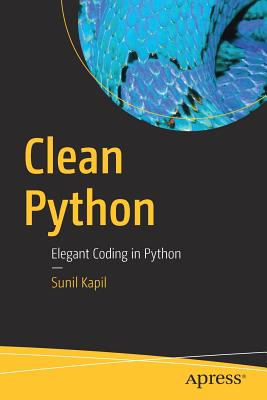Programming in Python 3: A Complete Introduction to the Python Language, 2/e (Paperback)
暫譯: Python 3 程式設計:Python 語言完整入門(第二版,平裝本)
Mark Summerfield
- 出版商: Addison Wesley
- 出版日期: 2009-11-01
- 售價: $1,930
- 貴賓價: 9.5 折 $1,834
- 語言: 英文
- 頁數: 656
- 裝訂: Paperback
- ISBN: 0321680561
- ISBN-13: 9780321680563
-
相關分類:
Python、程式語言
-
相關翻譯:
精通 Python 3 程式設計, 2/e (Programming in Python 3: A Complete Introduction to the Python Language, 2/e) (繁中版)
Python 3 程序開發指南, 2/e (修訂版) (簡中版)
已絕版
買這商品的人也買了...
-
 深入淺出設計模式 (Head First Design Patterns)
深入淺出設計模式 (Head First Design Patterns)$880$695 -
 深入淺出 Java 程式設計, 2/e (Head First Java, 2/e)
深入淺出 Java 程式設計, 2/e (Head First Java, 2/e)$880$695 -
 C++ Primer, 4/e (中文版)
C++ Primer, 4/e (中文版)$990$891 -
 Python Essential Reference, 4/e (Paperback)
Python Essential Reference, 4/e (Paperback)$1,930$1,834 -
 鳥哥的 Linux 私房菜-基礎學習篇, 3/e
鳥哥的 Linux 私房菜-基礎學習篇, 3/e$820$648 -
 程式設計師的自我修養-連結、載入、程式庫
程式設計師的自我修養-連結、載入、程式庫$580$493 -
 約耳趣談軟體-來自專案管理的現場實錄 (Joel on Software: And on Diverse and Occasionally Related Matters That Will Prove of Interest to Software Developers)
約耳趣談軟體-來自專案管理的現場實錄 (Joel on Software: And on Diverse and Occasionally Related Matters That Will Prove of Interest to Software Developers)$490$387 -
 深入淺出 Android 系統原理及開發要點
深入淺出 Android 系統原理及開發要點$450$351 -
 精通 Python 3 程式設計, 2/e (Programming in Python 3: A Complete Introduction to the Python Language, 2/e)
精通 Python 3 程式設計, 2/e (Programming in Python 3: A Complete Introduction to the Python Language, 2/e)$680$537 -
 深入淺出 Python (Head First Python)
深入淺出 Python (Head First Python)$780$616 -
 黑客列傳-電腦革命俠客誌-25 週年紀念版 (Hackers: Heroes of the Computer Revolution - 25th Anniversary Edition)
黑客列傳-電腦革命俠客誌-25 週年紀念版 (Hackers: Heroes of the Computer Revolution - 25th Anniversary Edition)$500$395 -
 笑談軟體工程:敏捷開發法的逆襲-導入 Scrum,讓你的軟體開發人生從黑白變彩色!
笑談軟體工程:敏捷開發法的逆襲-導入 Scrum,讓你的軟體開發人生從黑白變彩色!$550$435 -
 實戰封包分析-使用 Wireshark (Practical Packet Analysis: Using Wireshark to Solve Real-World Network Problems, 2/e)
實戰封包分析-使用 Wireshark (Practical Packet Analysis: Using Wireshark to Solve Real-World Network Problems, 2/e)$450$356 -
 $1,568The Art of Unit Testing: with examples in C#, 2/e (Paperback)
$1,568The Art of Unit Testing: with examples in C#, 2/e (Paperback) -
 Google 軟體測試之道-進行 Google 級的軟體測試 (How Google Tests Software)
Google 軟體測試之道-進行 Google 級的軟體測試 (How Google Tests Software)$520$411 -
 Python 錦囊妙計, 3/e (Python Cookbook, 3/e)
Python 錦囊妙計, 3/e (Python Cookbook, 3/e)$880$695 -
 Robi 洛比 2015/07/28 (No.66) <此為過刊雜誌,恕不接受退貨及取消訂單>
Robi 洛比 2015/07/28 (No.66) <此為過刊雜誌,恕不接受退貨及取消訂單>$599$569 -
 超圖解 Arduino 互動設計入門, 2/e
超圖解 Arduino 互動設計入門, 2/e$680$578 -
 改變世界的九大演算法 : 讓今日電腦無所不能的最強概念 (Nine Algorithms That Changed the Future: The Ingenious Ideas That Drive Today’s Computers)
改變世界的九大演算法 : 讓今日電腦無所不能的最強概念 (Nine Algorithms That Changed the Future: The Ingenious Ideas That Drive Today’s Computers)$360$284 -
 啊哈!圖解演算法必學基礎
啊哈!圖解演算法必學基礎$350$298 -
 C Primer Plus, 6/e (Paperback)
C Primer Plus, 6/e (Paperback)$2,600$2,470 -
 Android 程式設計入門、應用到精通--增訂第三版 (適用 5.X~1.X, Android Wear 穿戴式裝置)
Android 程式設計入門、應用到精通--增訂第三版 (適用 5.X~1.X, Android Wear 穿戴式裝置)$560$442 -
 精通 Python|運用簡單的套件進行現代運算 (Introducing Python: Modern Computing in Simple Packages)
精通 Python|運用簡單的套件進行現代運算 (Introducing Python: Modern Computing in Simple Packages)$780$616 -
 鳥哥的 Linux 私房菜-基礎學習篇, 4/e
鳥哥的 Linux 私房菜-基礎學習篇, 4/e$980$774 -
 經濟學, 9/e
經濟學, 9/e$820$779
相關主題
商品描述
A Fully Revised Edition Featuring New Material on Coroutines, Debugging, Testing, Parsing, String Formatting, and More
Python 3 is the best version of the language yet: It is more powerful, convenient, consistent, and expressive than ever before. Now, leading Python programmer Mark Summerfield demonstrates how to write code that takes full advantage of Python 3's features and idioms. Programming in Python 3, Second Edition, brings together all the knowledge you need to write any program, use any standard or third-party Python 3 library, and create new library modules of your own.
Summerfield draws on his many years of Python experience to share deep insights into Python 3 development you won't find anywhere else. He begins by illuminating Python's "beautiful heart": the eight key elements of Python you need to write robust, high-performance programs. Building on these core elements, he introduces new topics designed to strengthen your practical expertise-one concept and hands-on example at a time. Coverage includes
- Developing in Python using procedural, objectoriented, and functional programming paradigms
- Creating custom packages and modules
- Writing and reading binary, text, and XML files, including optional compression, random access, and text and XML parsing
- Leveraging advanced data types, collections, control structures, and functions
- Spreading program workloads across multiple processes and threads
- Programming SQL databases and key--value DBM files
- Debugging techniques-and using Test Driven Development to avoid bugs in the first place
- Utilizing Python's regular expression mini-language and module
- Parsing techniques, including how to use the third-party PyParsing and PLY modules
- Building usable, efficient, GUI-based applications
- Advanced programming techniques, including generators, function and class decorators, context managers, descriptors, abstract base classes, metaclasses, coroutines, and more
Programming in Python 3, Second Edition, serves as both tutorial and language reference. It assumes some prior programming experience, and is accompanied by extensive downloadable example code-all of it tested with Python 3 on Windows, Linux, and Mac OS X. This edition covers Python 3.0 and 3.1, and due to the Python language moratorium it is also valid for Python 3.2 which has the same language as Python 3.1.
商品描述(中文翻譯)
全面修訂版,新增協程、除錯、測試、解析、字串格式化等內容
Python 3 是迄今為止最好的語言版本:它比以往任何時候都更強大、方便、一致且表達力更強。現在,知名 Python 程式設計師 Mark Summerfield 展示了如何編寫充分利用 Python 3 特性和慣用法的程式碼。Programming in Python 3, Second Edition, 整合了您撰寫任何程式、使用任何標準或第三方 Python 3 函式庫以及創建您自己新函式庫模組所需的所有知識。
Summerfield 利用他多年來的 Python 經驗,分享了您在其他地方無法找到的 Python 3 開發深刻見解。他首先闡明了 Python 的「美麗核心」:撰寫穩健、高效能程式所需的八個關鍵元素。在這些核心元素的基礎上,他介紹了旨在加強您實務專業知識的新主題——每次一個概念和實作範例。內容包括:
- 使用程序式、物件導向和函數式編程範式在 Python 中開發
- 創建自定義套件和模組
- 撰寫和讀取二進位、文本和 XML 檔案,包括可選的壓縮、隨機存取以及文本和 XML 解析
- 利用進階資料類型、集合、控制結構和函數
- 將程式工作負載分散到多個進程和執行緒
- 編程 SQL 資料庫和鍵值 DBM 檔案
- 除錯技術——以及使用測試驅動開發來避免出現錯誤
- 利用 Python 的正則表達式迷你語言和模組
- 解析技術,包括如何使用第三方 PyParsing 和 PLY 模組
- 構建可用、高效的 GUI 應用程式
- 進階編程技術,包括生成器、函數和類裝飾器、上下文管理器、描述符、抽象基類、元類、協程等
Programming in Python 3, Second Edition, 同時作為教程和語言參考。它假設讀者具備一定的編程經驗,並附有大量可下載的範例程式碼——所有程式碼均在 Windows、Linux 和 Mac OS X 上使用 Python 3 測試過。本版涵蓋 Python 3.0 和 3.1,並由於 Python 語言的暫停,對於 Python 3.2 也有效,因為它與 Python 3.1 具有相同的語言。












